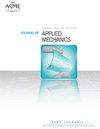Dramatic amplification of the flexoelectric effect in snapping surfaces
IF 2.8
4区 工程技术
Q2 MECHANICS
引用次数: 0
Abstract
Flexoelectricity exists in all inhomogeneously deformed dielectric materials and is greatly interesting in engineering science, especially in manufacturing microelectromechanical systems. However, the flexoelectricity is relatively small compared to the commonly known piezoelectricity. How to produce a considerably large flexoelectric effect and how to apply the effect to a large scale have concerned people for a long time. In this paper, we creatively enlarge the flexoelectric effect without decreasing the structure scale by harnessing the electromechanical instability—the snap-through instability—of a curved dielectric plate subjected to a concentrated load. We formulate the electrostatic energy of the system and obtain the governing equations by taking the first variation of the free energy. In the analysis, we find that the thickness of the plate and the initial configuration affect the onset of the snap-through. Beyond that, we notice that flexoelectricity can lower the critical load of the snap-through instability. Importantly, we find that a large flexoelectricity can be generated by harnessing the instability. For a dielectric plate with thickness 2 × 10−7 m, the effective electromechanical coefficient is equal to 35 pC/N in the beginning; however, by using the instability, the coefficient can be increased to as high as 740 pC/N, which is 21 times higher after the instability. In the end, we tune the electromechanical behaviors by designing the curved plate's thickness and configuration. This paper contributes to our understanding of the amplification of flexoelectric effects by harnessing snapping surfaces.挠性表面的挠性电效应的急剧放大
挠性电存在于所有非均匀变形的介质材料中,是工程科学,特别是制造微机电系统中非常有趣的问题。然而,与众所周知的压电相比,挠性电相对较小。如何产生相当大的挠电效应以及如何大规模应用挠电效应一直是人们关注的问题。在本文中,我们创造性地利用弯曲介质板在集中载荷作用下的机电不稳定性——卡通不稳定性,在不减小结构尺度的情况下扩大了挠性电效应。我们给出了系统的静电能,并通过自由能的一阶变化得到了控制方程。在分析中,我们发现板的厚度和初始配置影响卡通的发生。除此之外,我们还注意到,柔性电可以降低卡通不稳定性的临界负载。重要的是,我们发现利用不稳定性可以产生大量的柔性电力。对于厚度为2 × 10−7 m的介质板,初始有效机电系数为35 pC/N;而利用失稳后,系数可提高到740 pC/N,失稳后系数提高了21倍。最后,通过设计弯曲板的厚度和结构,对其机电性能进行了调整。这篇论文有助于我们理解利用断裂表面放大柔性电效应。
本文章由计算机程序翻译,如有差异,请以英文原文为准。
求助全文
约1分钟内获得全文
求助全文
来源期刊
CiteScore
4.80
自引率
3.80%
发文量
95
审稿时长
5.8 months
期刊介绍:
All areas of theoretical and applied mechanics including, but not limited to: Aerodynamics; Aeroelasticity; Biomechanics; Boundary layers; Composite materials; Computational mechanics; Constitutive modeling of materials; Dynamics; Elasticity; Experimental mechanics; Flow and fracture; Heat transport in fluid flows; Hydraulics; Impact; Internal flow; Mechanical properties of materials; Mechanics of shocks; Micromechanics; Nanomechanics; Plasticity; Stress analysis; Structures; Thermodynamics of materials and in flowing fluids; Thermo-mechanics; Turbulence; Vibration; Wave propagation

 求助内容:
求助内容: 应助结果提醒方式:
应助结果提醒方式:


